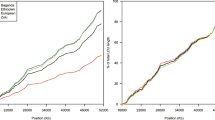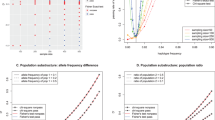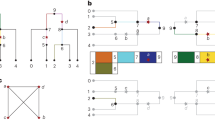Abstract
Linkage disequilibrium across the human genome is generally lower in West Africans than Europeans. However in the 5q31 region, which is rich in immune genes, we find significantly more examples of apparent nonrecombination between distant marker pairs in West Africans. Much of this effect is due to SNPs that are absent in Europeans, possibly reflecting recent positive selection in the West African population.
This is a preview of subscription content, access via your institution
Access options
Subscribe to this journal
Receive 6 digital issues and online access to articles
$119.00 per year
only $19.83 per issue
Buy this article
- Purchase on Springer Link
- Instant access to full article PDF
Prices may be subject to local taxes which are calculated during checkout




Similar content being viewed by others
References
Hinds DA, Stuve LL, Nilsen GB et al. Whole-genome patterns of common DNA variation in three human populations. Science 2005; 307: 1072–1079.
Ahmadi KR, Weale ME, Xue ZY et al. A single-nucleotide polymorphism tagging set for human drug metabolism and transport. Nat Genet 2005; 37: 84–89.
Daly MJ, Rioux JD, Schaffner SF et al. High-resolution haplotype structure in the human genome. Nat Genet 2001; 29: 229–232.
Rihet P, Traore Y, Abel L et al. Malaria in humans: Plasmodium falciparum blood infection levels are linked to chromosome 5q31–q33. Am J Hum Genet 1998; 63: 498–505.
Marquet S, Abel L, Hillaire D et al. Genetic localization of a locus controlling the intensity of infection by Schistosoma mansoni on chromosome 5q31–q33. Nat Genet 1996; 14: 181–184.
Ansel KM, Lee DU, Rao A . An epigenetic view of helper T cell differentiation. Nat Immunol 2003; 4: 616–623.
Lee GR, Fields PE, Griffin TJ et al. Regulation of the Th2 cytokine locus by a locus control region. Immunity 2003; 19: 145–153.
Ardlie KG, Kruglyak L, Seielstad M . Patterns of linkage disequilibrium in the human genome. Nat Rev Genet 2002; 3: 299–309.
Bamshad M, Wooding SP . Signatures of natural selection in the human genome. Nat Rev Genet 2003; 4: 99–111.
Sabeti PC, Reich DE, Higgins JM et al. Detecting recent positive selection in the human genome from haplotype structure. Nature 2002; 419: 832–837.
Luoni G, Verra F, Arca B et al. Antimalarial antibody levels and IL4 polymorphism in the Fulani of West Africa. Genes Immun 2001; 2: 411–414.
Zhang K, Jin L . HaploBlockFinder: haplotype block analyses. Bioinformatics 2003; 19: 1300–1301.
Rioux JD, Daly MJ, Silverberg MS et al. Genetic variation in the 5q31 cytokine gene cluster confers susceptibility to Crohn disease. Nat Genet 2001; 29: 223–228.
Noguchi E, Nukaga-Nishio Y, Jian Z et al. Haplotypes of the 5′ region of the IL-4 gene and SNPs in the intergene sequence between the IL-4 and IL-13 genes are associated with atopic asthma. Hum Immunol 2001; 62: 1251–1257.
Howard TD, Whittaker PA, Zaiman AL et al. Identification and association of polymorphisms in the interleukin-13 gene with asthma and atopy in a Dutch population. Am J Resp Cell Mol Biol 2001; 25: 377–384.
Stephens M, Smith NJ, Donnelly P . A new statistical method for haplotype reconstruction from population data. Am J Hum Genet 2001; 68: 978–989.
Ackerman H, Usen S, Mott R et al. Haplotypic analysis of the TNF locus by association efficiency and entropy. Genome Biol 2003; 4: R24.
Mott R . Marker selection by maximum entropy. http://www.well.ox.ac.uk/~rmott/SNPS/2003.
Gabriel SB, Schaffner SF, Nguyen H et al. The structure of haplotype blocks in the human genome. Science 2002; 296: 2225–2229.
Acknowledgements
This work was funded by a Marie Curie fellowship (GL), a Wellcome Trust research training fellowship (JF) and the Medical Research Council.
Author information
Authors and Affiliations
Corresponding author
Additional information
Supplementary information accompanies the paper on Genes and Immunity website (http://www.nature.com/gene).
Supplementary information
Rights and permissions
About this article
Cite this article
Luoni, G., Forton, J., Jallow, M. et al. Population-specific patterns of linkage disequilibrium in the human 5q31 region. Genes Immun 6, 723–727 (2005). https://doi.org/10.1038/sj.gene.6364250
Received:
Revised:
Accepted:
Published:
Issue Date:
DOI: https://doi.org/10.1038/sj.gene.6364250
This article is cited by
-
Innate immunity in ocular Chlamydia trachomatis infection: contribution of IL8 and CSF2 gene variants to risk of trachomatous scarring in Gambians
BMC Medical Genetics (2009)
-
Sequence variation, linkage disequilibrium and association with Crohn's disease on chromosome 5q31
Genes & Immunity (2006)
-
Implications of inter-population linkage disequilibrium patterns on the approach to a disease association study in the human MHC class III
Immunogenetics (2006)



